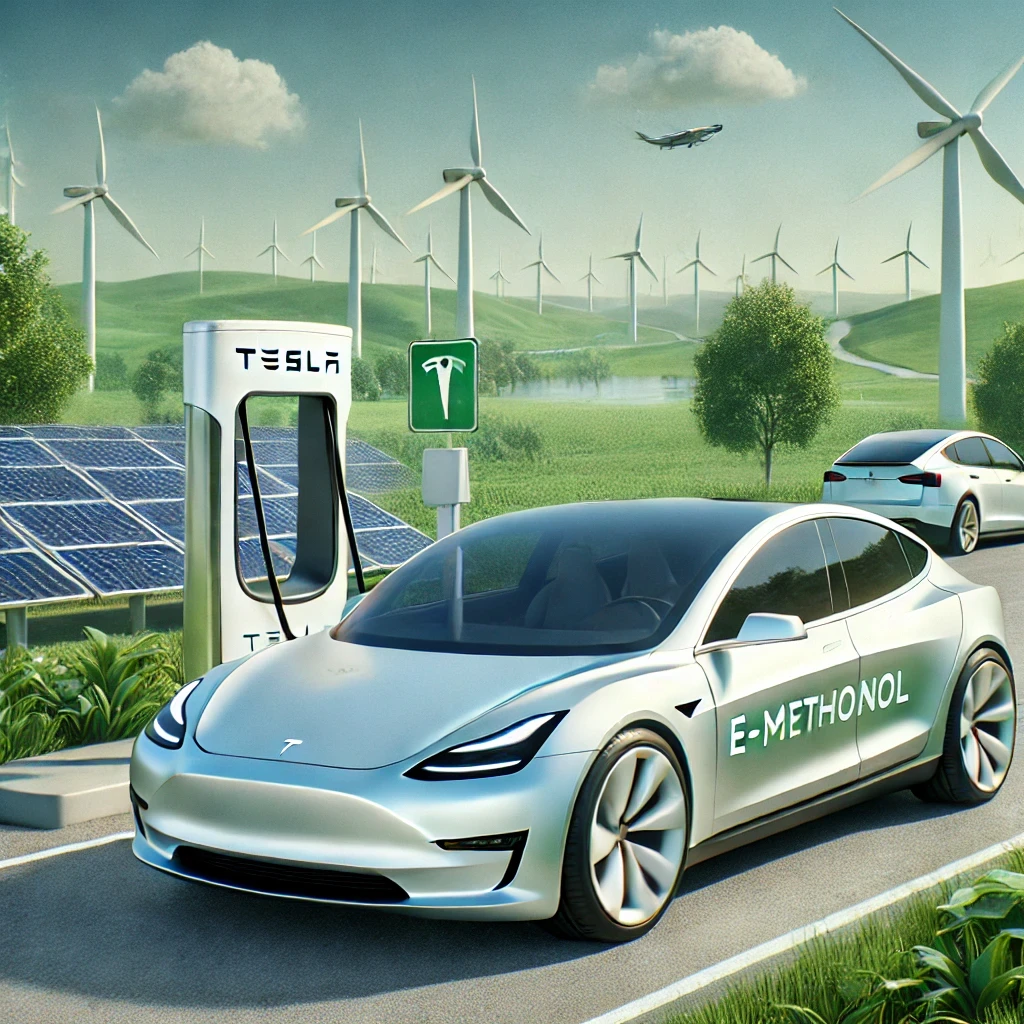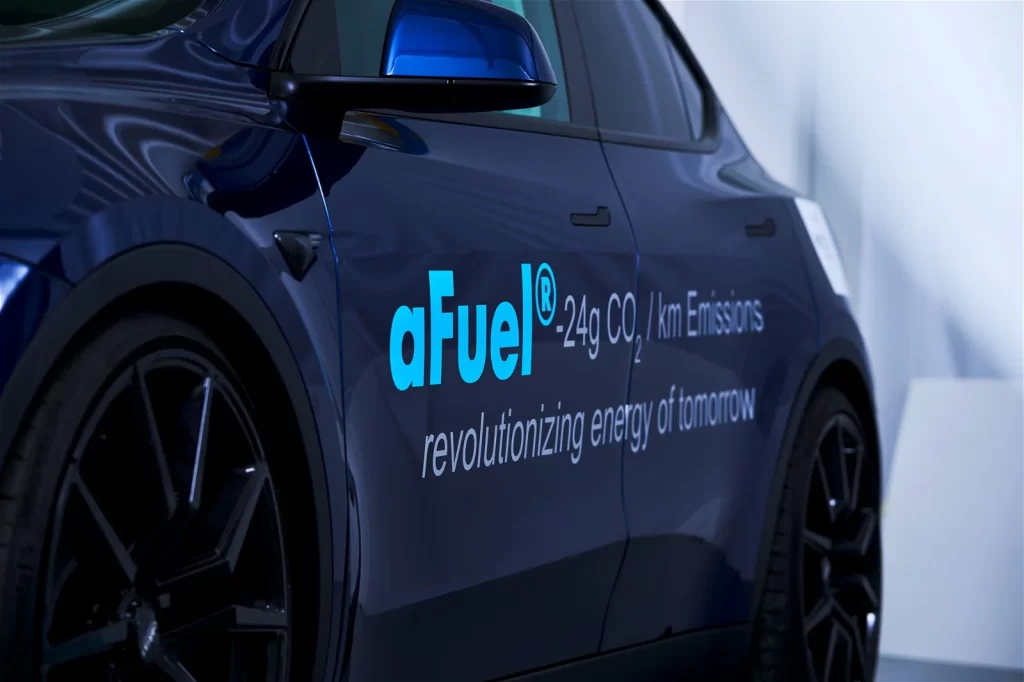The global pursuit of sustainable energy solutions has propelled e-methanol into the spotlight as a promising alternative fuel. Its potential to decarbonize various sectors, notably maritime transport, has garnered significant attention. The e-methanol revolution in maritime transport is now spreading to the automotive industry: The hybrid car designed in collaboration between Tesla and Obrist is also capable of utilizing e-methanol.
E-methanol, or renewable methanol, is produced by synthesizing carbon dioxide (CO₂) captured from the atmosphere or by gasifying energy wood with hydrogen derived from renewable electricity. This process results in a liquid fuel that can be utilized in internal combustion engines and fuel cells, offering a carbon-neutral alternative to conventional fossil fuels.
The production of e-methanol involves several steps: capturing CO₂, generating hydrogen through water electrolysis powered by renewable energy sources, and synthesizing these components into methanol. This method not only recycles CO₂ but also provides a versatile energy carrier that can be stored and transported using existing infrastructure.
E-Methanol in Maritime Transport
The maritime industry, responsible for approximately 3% of global greenhouse gas emissions, is under increasing pressure to adopt cleaner fuels. E-methanol presents a viable solution due to its compatibility with existing ship engines and fueling infrastructure.
Studies have shown that methanol can be used as a marine fuel with minimal modifications to current ship designs. Its liquid state at ambient temperature simplifies storage and handling compared to gaseous alternatives like hydrogen. Moreover, methanol combustion produces fewer pollutants, such as sulfur oxides and particulate matter, contributing to improved air quality.
The International Maritime Organization (IMO) has recognized methanol’s potential, adopting guidelines for its use as a marine fuel. This regulatory support has spurred interest from shipping companies seeking to reduce their environmental footprint.

Tesla and Obrist’s HyperHybrid: A Novel Approach
In the automotive sector, Tesla, in collaboration with Austrian engineering firm Obrist, has developed a prototype known as the “HyperHybrid.” This vehicle combines a small battery with a methanol-powered engine, aiming to offer a carbon-negative transportation solution. Unlike traditional cars, electric cars do not need bulky internal combustion engines, exhaust systems, or large fuel tanks. This absence of mechanical components under the hood allows automakers to utilize the freed-up space creatively. Obrist has installed its small 1-liter two-cylinder gasoline generator in this kind of a space, called the frunk. This generator makes up to 4o kW when run on gasoline or 45 kW when run on methanol.
The HyperHybrid operates by utilizing the battery for short trips and urban driving, while the methanol engine extends the vehicle’s range for longer journeys. This dual-system approach leverages the high energy density of methanol and the efficiency of electric propulsion.
Obrist’s methanol engine is designed to be nearly vibration-free, enhancing driving comfort. The company claims that this setup can achieve a range of up to 1,000 kilometers, addressing range anxiety associated with electric vehicles.
Advantages of E-Methanol
- Compatibility with Existing Infrastructure: E-methanol can be transported and stored using current fuel infrastructure, facilitating a smoother transition from fossil fuels.
- Environmental Benefits: When produced using renewable energy and CO₂ capture, e-methanol can achieve a carbon-neutral or even carbon-negative lifecycle.
- Versatility: E-methanol can be used in various applications, including transportation, power generation, and as a feedstock in the chemical industry.
Challenges and Considerations
Despite its potential, several challenges hinder the widespread adoption of e-methanol:
- Production Costs: The current production of e-methanol is more expensive than conventional fuels, primarily due to the costs associated with renewable energy and CO₂ capture technologies. These costs can be reduced by recycling components within the production system and utilizing waste heat from the processes.
- Renewable Energy Demand: Large-scale e-methanol production requires substantial amounts of renewable electricity, which could strain existing renewable energy capacities. Luckily, there are plenty of new renewable energy production projects in the pipeline.
- Policy and Regulation: Supportive policies and regulations are crucial to incentivize the adoption of e-methanol and to ensure the development of necessary infrastructure. EU is already heavily promoting this change in maritime transport.
Future Outlook is Bright

The integration of e-methanol into sectors like maritime transport and automotive industries represents a significant step toward decarbonization. Innovations such as Tesla and Obrist’s HyperHybrid demonstrate the potential for e-methanol to complement electric mobility, especially in applications where battery limitations persist.
However, achieving widespread adoption will require concerted efforts to reduce production costs, expand renewable energy capacities, and implement supportive policies. As the world transitions toward sustainable energy solutions, e-methanol is a promising candidate to play a pivotal role in the future energy landscape.
Read More:
- Obrist: The HYPERHYBRID from Voralberg
- Teslarati: Tesla Model Y converted into green hydrogen car to show “Hyper Hybrid” innovations
- Methanol Institute: FuelEU Maritime & ETS
- Interesting Engineering: A New ‘Hyper Hybrid’ Tesla From Germany Cuts Carbon Emissions. With Methanol?
- EcoNews: Tesla says goodbye to the hydrogen dream: This is its new fuel (and it’s not electric)
- Future Fuels: Marine Methanol Future-Proof Shipping Fuel
- Drive Spark: Tesla Unveils Plan For First Hydrogen-Powered Vehicle, Model H By 2026
- Green Maritime Methanol
- Elektroauto News: Obrist „HyperHybrid“: PHEV mit Methanol auf Tesla-Basis
- Inside EVS: We Drive A Hybrid Tesla Model 3 That Runs On Gasoline
- Youtube/Inside EVS: This Tesla Runs on Gasoline (and Methanol) – Obrist HyperHybrid Interview & Test Drive

